Queen of the Long Roads: Amazing Facts about Appian Way / Via Appia in Rome
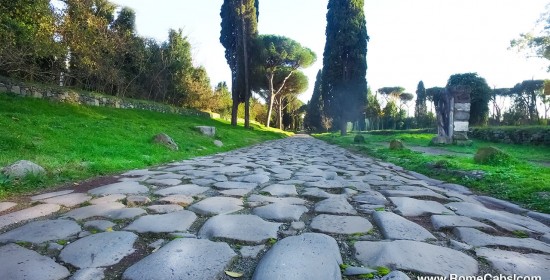
PRO TIP: Curious about the Ancient Appian Way/ Via Appia in Rome? Save this article in your browser's "Rome" folder for easy reference during your trip planning. For an unparalleled experience in a historically rich city like Rome, discover our top-rated Rome Tours and Rome Shore Excursions from Civitavecchia for a luxurious and comfortable exploration of Rome's ancient wonders
Welcome to Stefano's RomeCabs, where we invite you to embark on a fascinating journey through time along the historic Via Appia, also known as the Appian Way. Via Appia has witnessed centuries of human history and a route that connected civilizations.
On our Along Rome’s Empire Roads Tour, our guests experience the thrill of walking in the footsteps of emperors, soldiers, merchants, and everyday Romans who once traveled this iconic road.
In this blog, we will unveil the marvels of this ancient road, often referred to as the "Queen of the Long Roads" and considered one of the Seven Wonders of Ancient Rome.
From its remarkable construction to its significant role in shaping the Roman Empire, Via Appia is a testament to the grandeur and ingenuity of ancient Rome. Get ready to immerse yourself in the splendor of the ancient world, as we explore the amazing facts and hidden treasures of the Ancient Appian Way (Via Appia) in Rome.
Amazing Facts about Via Appia in Rome
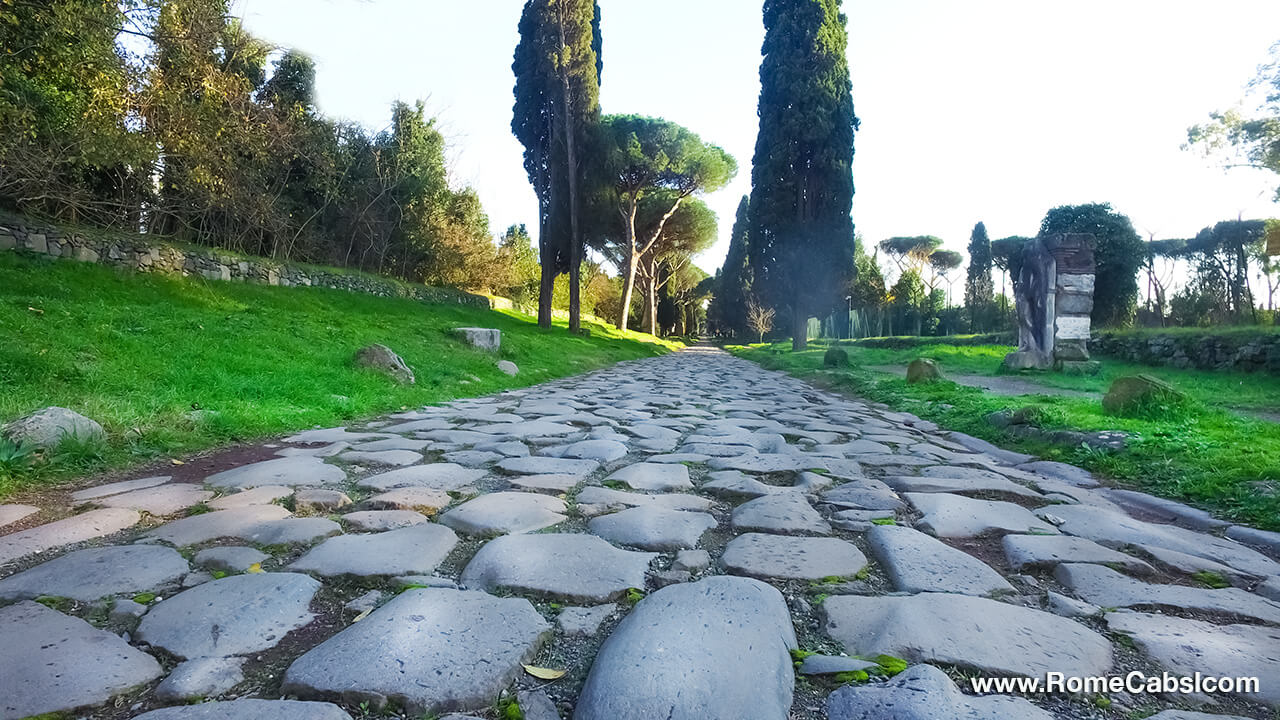
How Via Appia / Appian Way got its name:
The name "Appia" is derived from its founder, Appius Claudius Caecus. In 312 BC, Appius Claudius Caecus, a Roman censor, initiated bold public works to address supply issues in Rome. One of his notable projects was the construction of a road known as Via Appia. Although Appius Claudius expressed great vision in these public works, he eventually lost his eyesight and earned the nickname "Caecus" or "blind."
History and Purpose of Via Appia / Appian Way
The Via Appia holds a significant place in history as one of the earliest and most important Roman roads.
As mentioned above, construction began in 312 BC during the Roman Republic commissioned by the Roman censor Appius Claudius Caecus. The primary purpose behind the construction of Via Appia was to enhance military and commercial transportation between Rome and its expanding territories.
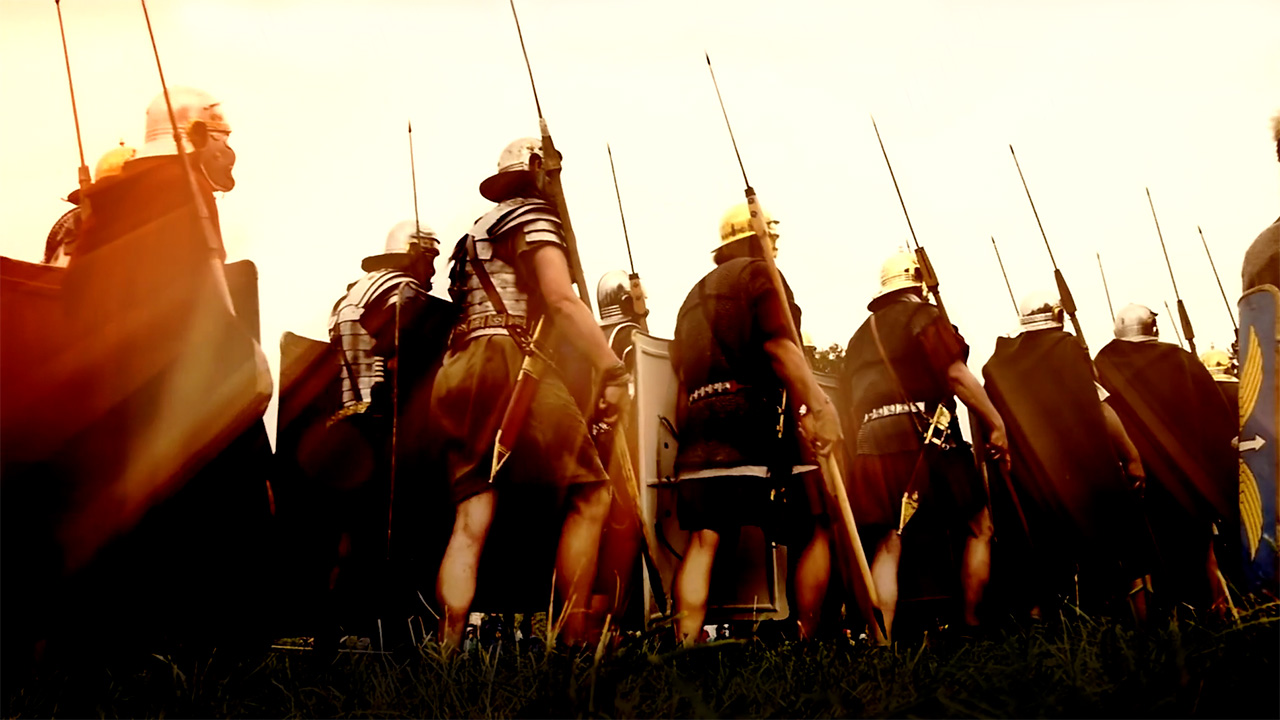
The road served as a crucial artery for the movement of troops, supplies, and trade caravans, as well as a means of connecting Rome to its southern regions. It facilitated the Roman conquest of southern Italy, allowing for the swift and efficient deployment of armies and the consolidation of Roman control.
In addition to its military and strategic significance, Via Appia played a crucial role in facilitating trade and commerce during ancient times. It connected Rome to important trade routes and commercial centers, contributing to the economic growth and prosperity of the empire.
Role of Via Appia in Ancient Roman Politics
The Via Appia also played a role in Roman political propaganda. The road was adorned with monuments, tombs, and milestones that served as symbols of Roman power and cultural identity. The construction of grand structures along the Via Appia showcased the wealth and magnificence of Rome, solidifying its political and cultural dominance.
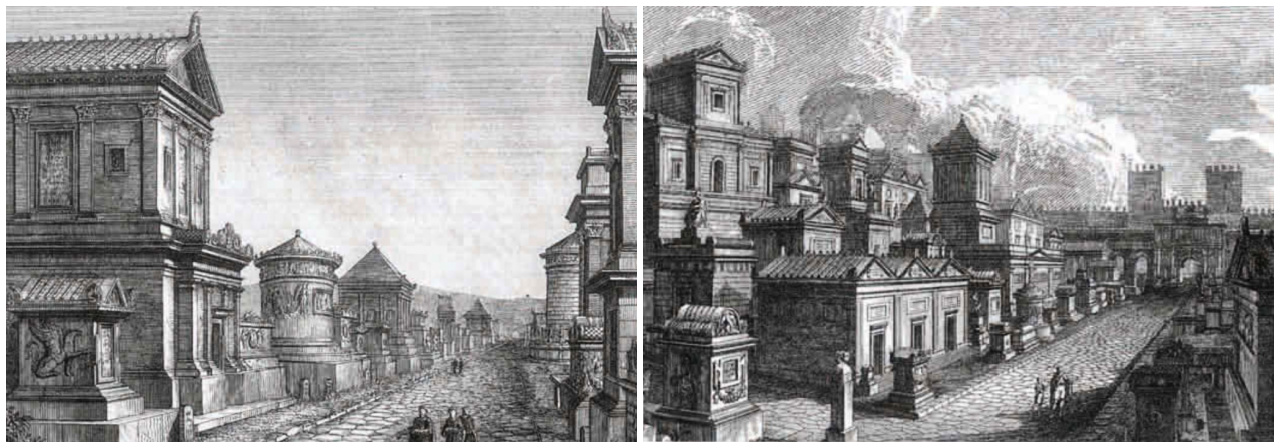
Furthermore, the Via Appia became a platform for political communication and public display. It hosted triumphal processions, military parades, and public ceremonies that showcased Roman military victories and celebrated political achievements. These spectacles served to reinforce the authority of Roman leaders and foster a sense of unity and loyalty among Roman citizens.
In the end, Via Appia served as a strategic military road, a means of political control and governance, an economic artery, a symbol of Roman power and identity, and a platform for political communication and spectacle.
The "Queen of the Long Roads" - Regina Viarum
According to records by Statius, a 1st century CE Greco-Roman poet, Via Appia was often referred to as the "Queen of Long Roads" ( Appia longarum... regina viarum ) due to its grandeur, historical importance, and impressive engineering. Being one of the first long-distance paved roads in the Roman Empire, it also set the standard for future road construction.
Appian Way / Via Appia Construction Techniques:
The construction of Via Appia was a remarkable feat of engineering for its time.
The road covered a distance of approximately 500 kilometers, extending from Rome to the port city of Brundisium (modern-day Brindisi) on the Adriatic Sea.
The initial phase involved preparing a leveled dirt path, which served as the foundation for the road's construction. Skilled craftsmen then laid small stones and mortar to form a solid base. Next, a layer of gravel was added, providing stability and durability. The crowning touch was the precise placement of interlocking stones, meticulously fitted together to create a smooth and seamless surface.
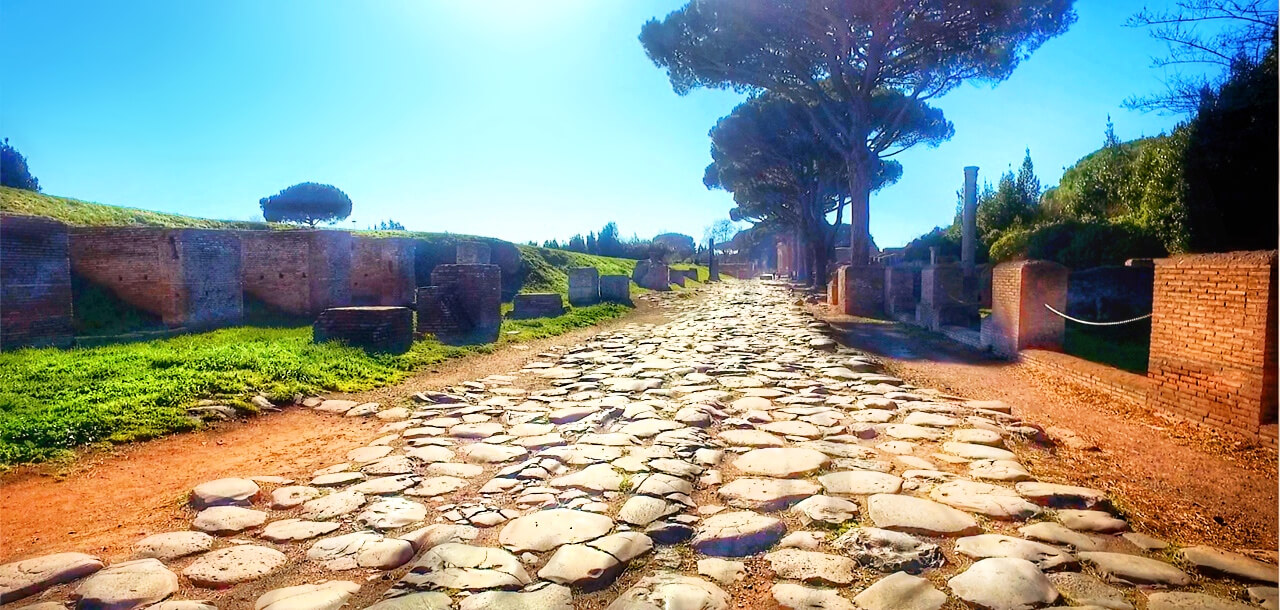
According to the historian Procopius, the stones were so expertly joined that they appeared to have grown together naturally, rather than being deliberately arranged. This remarkable craftsmanship ensured a sturdy and reliable road for travelers. Additionally, the road was designed with a gentle slope in the center to facilitate water runoff, while ditches on either side, protected by retaining walls, helped channel excess water away from the road.
The construction of Via Appia showcased Roman engineering prowess, as the road had to overcome various geographical challenges, including marshy areas, hills, and rivers. To address these obstacles, the Romans built bridges, viaducts, and causeways, ensuring a continuous and uninterrupted path along the entire route. The construction techniques employed on Via Appia became a model for subsequent Roman roads, with its innovative design and solid foundation setting the standard for road building in the Roman Empire.
The meticulous construction techniques and thoughtful engineering employed in the creation of the Appian Way stand as a testament to the skill and ingenuity of the ancient Romans, ensuring the road's endurance for centuries to come.
Long after the rise and fall of the Roman Empire, remnants of Via Appia can still be seen in various parts of Italy, particularly near Rome. These archaeological remains, including sections of the original paving stones, tombs, and monuments, stand as a testament to the enduring legacy of the Appian Way. As you walk along the Via Appia Antica, the ancient section of the road near Rome, you can trace the footsteps of ancient Romans and experience the awe-inspiring history that this legendary road holds.
Milestones and Markers along Appian Way / Via Appia
Along the ancient Via Appia, milestones and markers played a crucial role in providing distance measurements and important information for travelers. These stone markers served as guideposts, helping travelers navigate the road and indicating the distance to significant destinations.
The milestones along Via Appia were typically made of stone and placed at regular intervals, usually one Roman mile apart (approximately 1,480 meters). These milestones, known as miliaria, featured inscriptions indicating the distance from the road's starting point, usually Rome itself. They also often included the name of the Roman emperor at the time of their installation, commemorating their contributions to the road's construction and maintenance.
The milestones along Via Appia served multiple purposes. They provided important information for travelers, ensuring they remained on the correct path and estimating the distance to their destination. These markers were particularly valuable for military operations, as they helped Roman soldiers track their progress and plan their movements effectively.
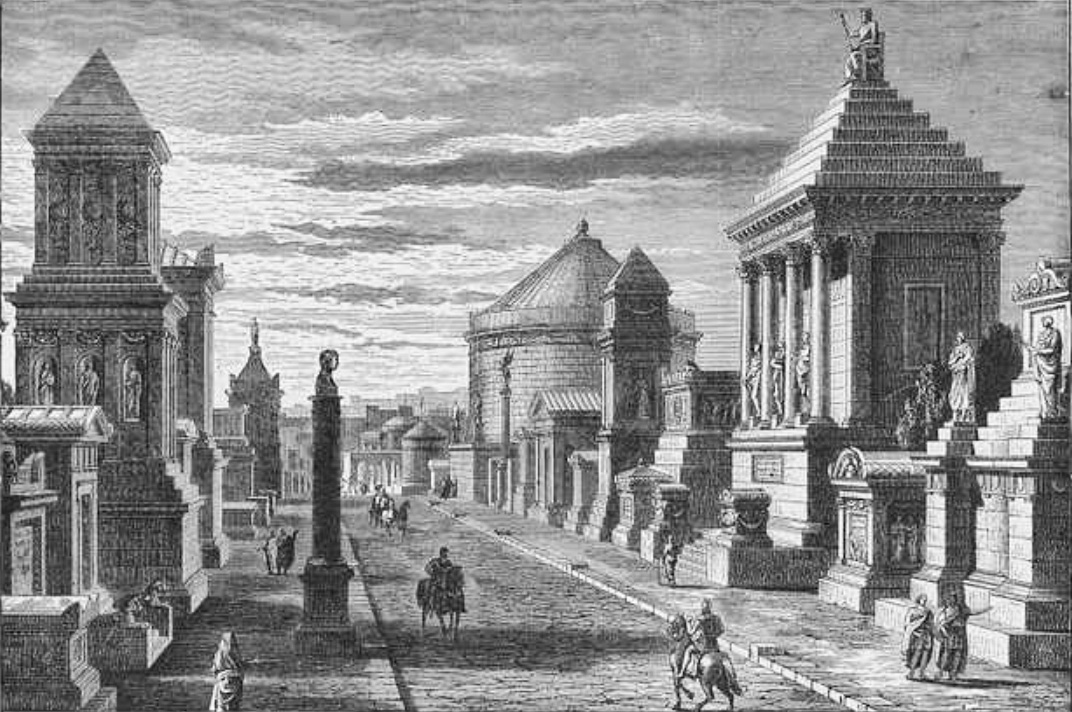
In addition to the milestones, other markers and inscriptions were present along Via Appia. These included honorary columns, dedicatory plaques, and boundary stones, which served various functions. Honorary columns were erected to commemorate significant events or achievements, often honoring emperors or military victories. Dedicatory plaques expressed gratitude or dedication to deities or influential figures. Boundary stones marked the borders of private properties, delineating ownership rights along the road.
While many of the original milestones and markers along Via Appia have been lost to time, some replicas and remnants can still be found along the route, particularly in the archaeological areas near Rome. These artifacts provide glimpses into the past and allow visitors to imagine the journey of ancient travelers along the historic Appian Way.
Walking along Via Appia Antica, the preserved section of the road, you can still encounter some of these milestones and markers, transporting you back in time and offering a tangible connection to the ancient Roman world.
Appian Way, Spartacus, and the Third Servile War
In 73 BC, the Third Servile War unfolded in ancient Rome led by Spartacus, a formidable ex-gladiator from Capua. It was a response to the prevalent practice of slavery, affecting a significant portion of Italy's population.
Spartacus and his rebel forces achieved remarkable victories over Roman armies during the two-year conflict. However, their attempted escape from Italy led them into a trap in Apulia. The Romans, well-acquainted with the region, strategically encircled the rebels, resulting in their defeat at the Siler River.
After the battle, captured rebels faced the grim fate of crucifixion. Along the 200-kilometer Via Appia, from Rome to Capua, approximately 6,000 slaves were crucified as a chilling warning against challenging Roman authority.

This dark chapter in history serves as a haunting reminder of the brutal consequences for those who defied the Roman Empire. The Via Appia, once a symbol of grandeur, became a testament to the Roman judgment against rebellious slaves. Walking its ancient stones today, we can't help but feel the weight of history and the sacrifices made along this historic path.
Appian Way's Connection to Saint Peter
Via Appia holds a significant connection to Saint Peter, one of the most revered figures in Christianity. According to an ancient oral tradition, a remarkable encounter took place along the Via Appia involving the apostles Peter and Jesus.
Fleeing from Rome to evade martyrdom, Peter is said to have come face to face with Jesus, to whom he uttered the poignant words, "Domine quo vadis" meaning "Lord, where are you going?"
Jesus responded with a profound statement, "Venio Romam iterum crucifigi" or "I am coming to Rome to be crucified again." This encounter left Peter with a profound realization, prompting him to turn back and embrace his destiny, while Jesus disappeared from sight. However, as a lasting testament to this extraordinary event, the footprints of Jesus were imprinted on the road where the church now stands.
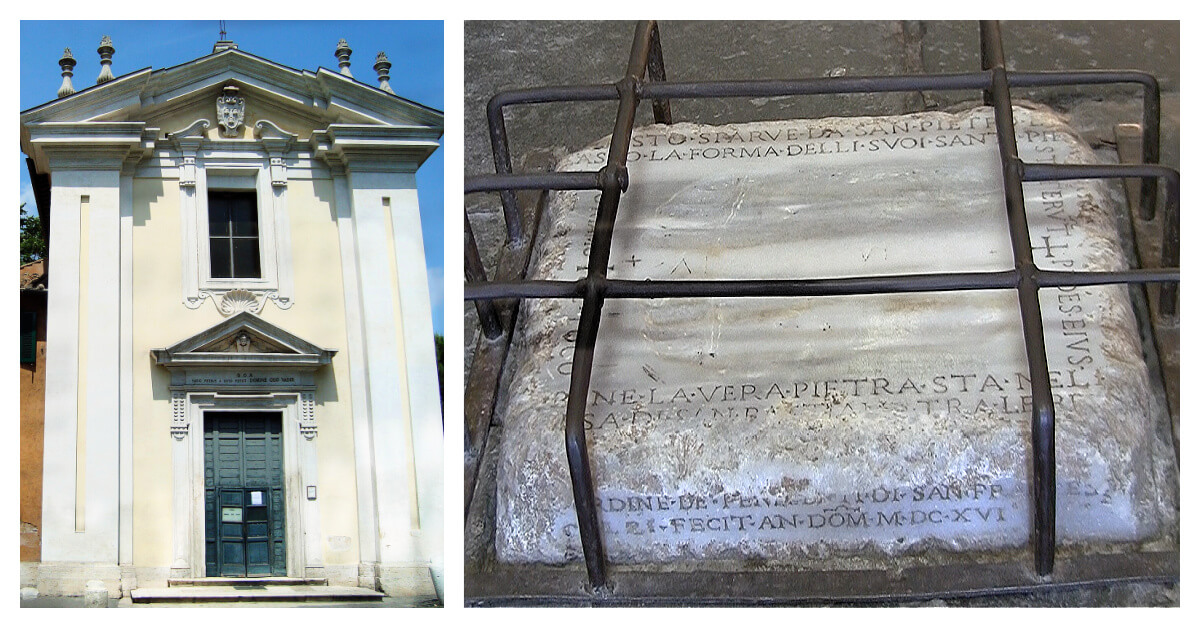
Within the confines of the Church, a stone bears the sacred imprints known as the "footprints of His holy feet." These footprints are believed to be a replica of the original, which is preserved in the Basilica of San Sebastiano.
The Church of Domine Quo Vadis is also known as Santa Maria in Palmis, drawing its name from the episode of the (palmis) prints left by Jesus. It stands as a tangible reminder of the profound encounter between Peter and Jesus, inspiring contemplation and reflection on the enduring legacy of faith and sacrifice.
Underground Catacombs along Ancient Appian Way
The Christian Catacombs are quite popular on Rome Tours and Rome excursions from Civitavecchia for the unique experience. The catacombs along Via Appia hold a captivating history that dates back to ancient times.
Beneath the surface of Rome, a labyrinth of tomb-lined tunnels extends for miles, delving deep into the layers of history. These underground burial sites became necessary due to Roman law prohibiting burials within the city walls. Via Appia, with its proximity to Rome, became a preferred location for the construction of catacombs.
These Christian catacombs served as the final resting place for many early Christians, some of whom would later be revered as martyrs and saints. In a poignant display of devotion, others carved out niches nearby to lay their loved ones to rest in the proximity of these revered Christian heroes.
As the centuries unfolded, the catacombs of Rome slipped into obscurity during the Middle Ages, their existence fading from collective memory. It was not until much later, when the spirit of exploration and curiosity reawakened, that these subterranean burial grounds were rediscovered. During the Romantic age, adventurous tourists embarking on the grand tour would venture into the catacombs, their way lit by the flickering glow of candlelight. It was during this era that legends began to take root, fueling tales of Christians seeking refuge from persecution within the catacombs. However, in truth, these underground passages were not clandestine hideouts but rather humble, low-budget cemeteries.
Several notable catacombs can be found along Via Appia, each with its unique characteristics and stories. The Catacombs of San Callisto (St. Callixtus) are among the most renowned and extensive catacombs in Rome. They served as the final resting place for numerous early Christians, including several popes.
The Catacombs of San Sebastiano (St. Sebastian) is another significant site, housing the remains of early Christian martyrs.
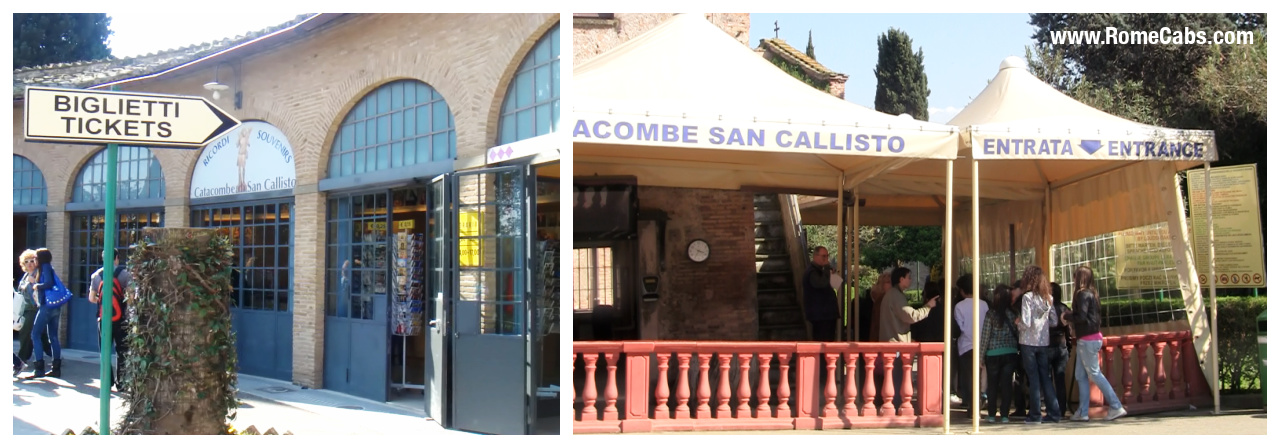
To visit the catacombs along Via Appia, it is recommended to plan ahead and join a guided tour that is included with ticket admission and available in different languages. These guided group tours offer a fascinating insight into the underground world, providing historical context and highlighting the significance of these sacred sites. Guided tours ensure a safe and informative experience while exploring the labyrinthine tunnels and chambers of the catacombs.
During the visit, you will witness the unique architectural features of the catacombs, such as narrow passageways, crypts, and burial niches carved into the walls. Some catacombs contain remarkable frescoes, depicting biblical scenes and early Christian symbols.
It is important to note that each catacomb has its visiting regulations and restrictions. It is advisable to check the specific opening hours, ticketing procedures, and any dress code requirements before your visit. Many catacombs can be accessed by public transportation, making it convenient to reach these intriguing underground sites.
Visiting the catacombs along Via Appia either on your own or on a private Rome tour or Rome shore excursion offers a profound glimpse into the ancient world and the early Christian history of Rome. It is a chance to connect with the past, paying tribute to the individuals who found eternal rest within these subterranean chambers.
- ALSO READ: Tips on Getting Around Rome with Ease
Circus of Maxentius: Roman racing chariot stadium
Commissioned by Emperor Maxentius in the early 4th century as a tribute to his son, Circus of Maxentius stadium stands as a remarkable testament to the grandeur and entertainment of ancient Rome, designed to host numerous thrilling chariot races, equestrian events, athletic competitions, and gladiatorial contests, all meant to entertain and captivate the Roman populace.
The colossal structure measured approximately 513 meters (1,680 feet) in length and 85 meters (279 feet) in width making it one of the largest circuses in ancient Rome capable of accommodating tens of thousands of enthusiastic spectators.
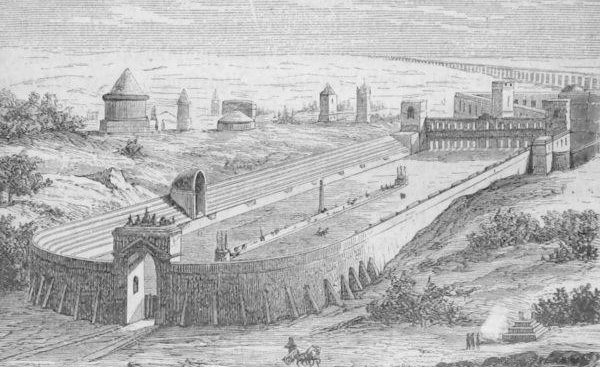
The racing track itself was covered with sand, known as "arena", offering a suitable surface for the chariots to race. The circus featured an elongated central spina, or barrier, adorned with elaborate decorations, including statues, obelisks, and monuments, enhancing the visual splendor of the chariot races and other spectacles that took place within the arena.
The spinal was flanked by seating tiers rising on either side. These tiers provided seating for the audience, ranging from the social elite occupying the higher rows to the common people filling the lower sections.
However, the magnificence of the Circus of Maxentius eventually succumbed to the passage of time and the decline of the Roman Empire. Much of the structure was gradually dismantled or repurposed during the medieval era, leading to its partial destruction.
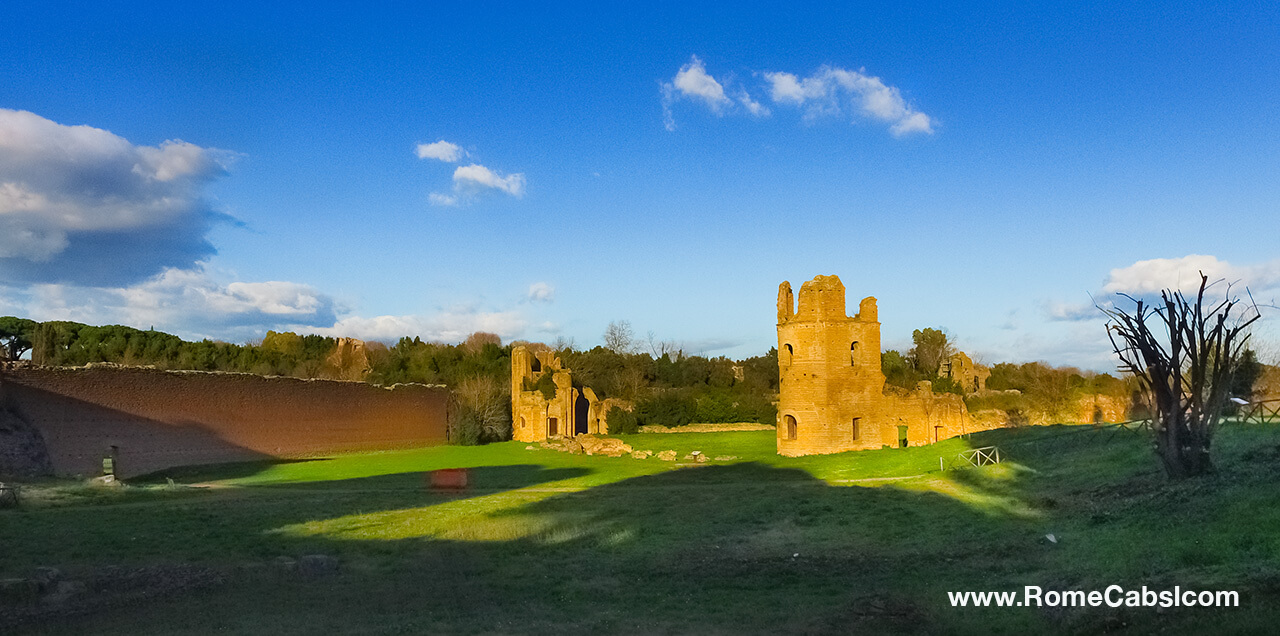
While not as famous as Circus Maximus which is included in most private tours of Rome, Circus Maxentius is just as fascinating with more vestiges of its ancient grandeur than Circus Maximus.
Today's visitors can still explore the ruins of this once-glorious arena, standing as a testament to the opulence and grandeur of ancient Rome. Located between the second and third miles along Via Appia, occupying a prominent position between the catacombs of San Sebastiano and the imposing tomb of Caecilia Metella, the remnants of the Circus of Maxentius offer a remarkable insight into the ancient world, allowing modern-day travelers to immerse themselves in the rich history and vibrant culture of this iconic city.
Important Tombs along Appian Way / Via Appia
Via Appia is lined with impressive tombs and mausoleums, including the Tomb of Cecilia Metella that reflect the wealth and status of ancient Roman families and provide a glimpse into their funerary traditions.
The Tomb of Cecilia Metella is a cylindrical mausoleum that was built in the 1st century BC. This monumental structure was constructed to honor Cecilia Metella, a noblewoman from the influential Roman family of the Caecilii Metellii. The tomb, originally adorned with intricate marble decorations, served as a final resting place for Cecilia Metella and possibly other family members.
The imposing exterior of the tomb is characterized by its robust cylindrical shape and towering height, creating a striking silhouette against the skyline. Constructed from large travertine blocks, the tomb showcases the exceptional craftsmanship of Roman masonry. The somber and austere appearance of the exterior reflects the solemnity and reverence associated with ancient Roman burial customs.
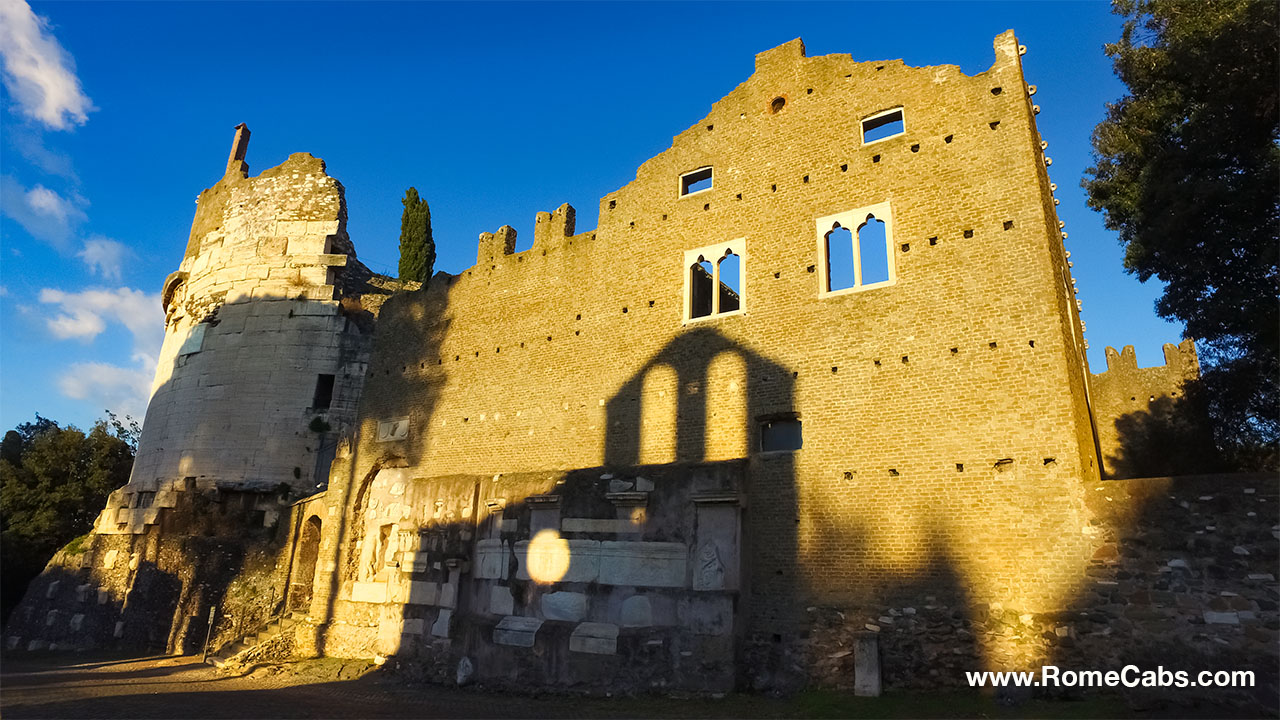
Venturing inside the Tomb of Cecilia Metella reveals a space that once housed funerary urns or sarcophagi, where the remains of the deceased were interred. The interior, though now largely empty, provides a glimpse into the intricate architectural design and craftsmanship of the time.
The circular chamber and the vaulted ceilings are testaments to the enduring legacy of Cecilia Metella, her prominent family, the values and traditions of ancient Rome, and the ancient Roman engineering and architectural prowess.
- ALSO READ: The Rise and Fall of the Roman Empire
The Appian Way Aqueduct: Aqua Appia
The aqueduct of Via Appia, known as the Aqua Appia, stands as a remarkable testament to the engineering prowess of ancient Rome. It was the first aqueduct constructed in Rome, commissioned in 312 BC by the Roman censor Appius Claudius Caecus, after whom it was named.
The Aqua Appia served a crucial role in supplying Rome with an estimated 73,000 cubic meters of water per day. This substantial volume of water played a vital role in meeting the needs of the growing population and supporting the city's various activities.
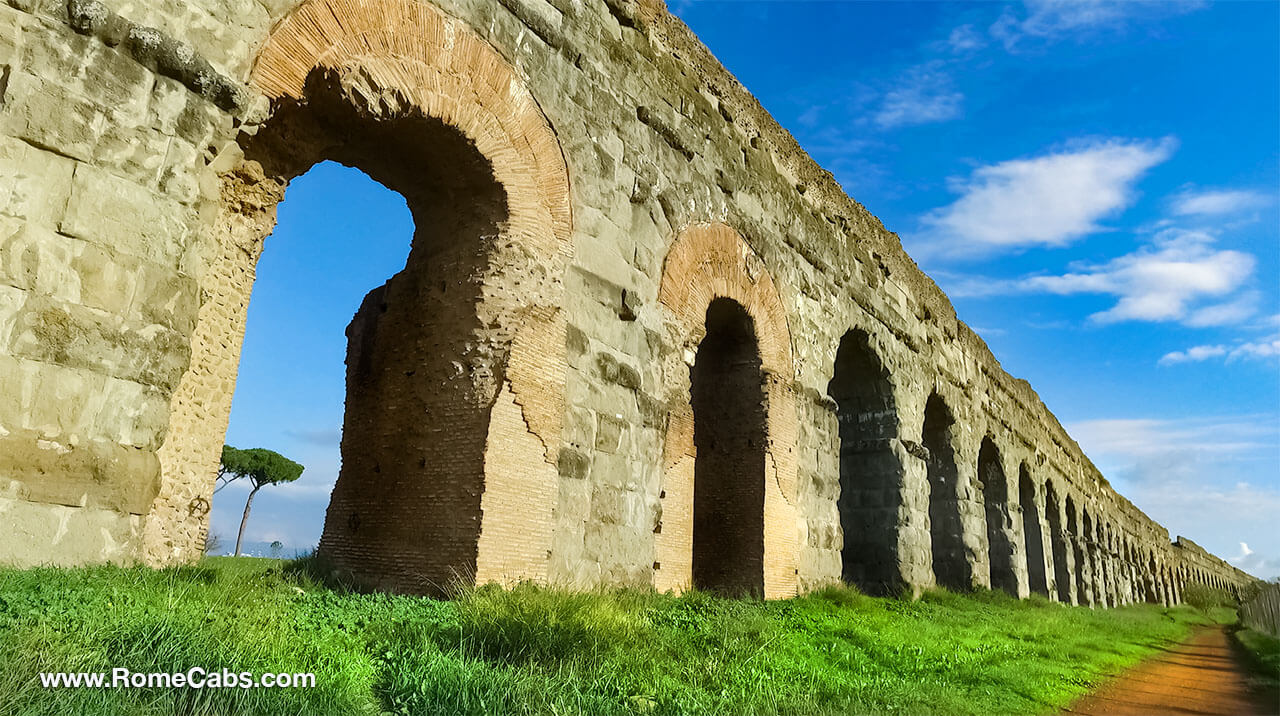
The construction of the Aqua Appia involved impressive engineering techniques for the time. The aqueduct spanned a distance of approximately 16 kilometers, originating from springs in the Alban Hills and making its way to Rome. The aqueduct was built underground for most of its length, utilizing a combination of cut stone, vaulted tunnels, and open channels. This innovative design allowed the aqueduct to traverse various terrains, including hills and valleys while maintaining a steady flow of water.
The Aqua Appia marked the beginning of Rome's extensive network of aqueducts, setting a precedent for future engineering marvels. Its construction demonstrated the Romans' advanced knowledge of hydraulics and their ability to design and implement large-scale infrastructure projects.
While the visible remains of the Aqua Appia are limited today, its historical significance cannot be understated. It laid the foundation for the development of subsequent aqueducts that would shape the city's growth and prosperity. The Aqua Appia stands as a testament to the ingenuity and engineering prowess of ancient Rome, forever leaving its mark on the city's history. Together with the other aqueducts in the park, Aqua Appia is a popular destination on private tours of Rome and Rome Shore Excursions for a wonderful escape from the hustle and bustle of the Eternal City.
Appian Way Regional Park
Many visitors are unaware of the park's existence and miss out on the opportunity to explore its hidden gems. Appian Way Park, also known as Parco Regionale dell'Appia Antica, is a sprawling green oasis nestled along the ancient Appian Way in Rome. Spanning over 3,400 acres, this expansive park offers a serene escape from the bustling city, inviting visitors to immerse themselves in the rich history and natural beauty of the Roman countryside.
Lush meadows, rolling hills, and towering umbrella pine trees create a picturesque landscape that transports you back in time. This idyllic setting provides a peaceful retreat where you can relax, explore, and reconnect with nature.
The park is home to numerous ancient Roman ruins and archaeological sites, offering a glimpse into the past. Ruins of tombs, mausoleums, and villas dot the landscape, showcasing the grandeur and opulence of ancient Rome. One of the park's highlights is, of course, the preserved section of the Appian Way itself.
Let's explore some of the notable landmarks found within the park that can be enjoyed on private tours of Rome.
Aqueducts Park:
This section of the park is dedicated to the impressive aqueducts that once supplied water to ancient Rome. Here, you can marvel at the towering arches and marvel at the engineering marvels of structures such as the Aqua Claudia and the Marcia Aqueduct. The aqueducts stand as a testament to the ingenuity of the ancient Romans and their mastery of water management. They are considered one of the Seven Wonders of Ancient Rome.
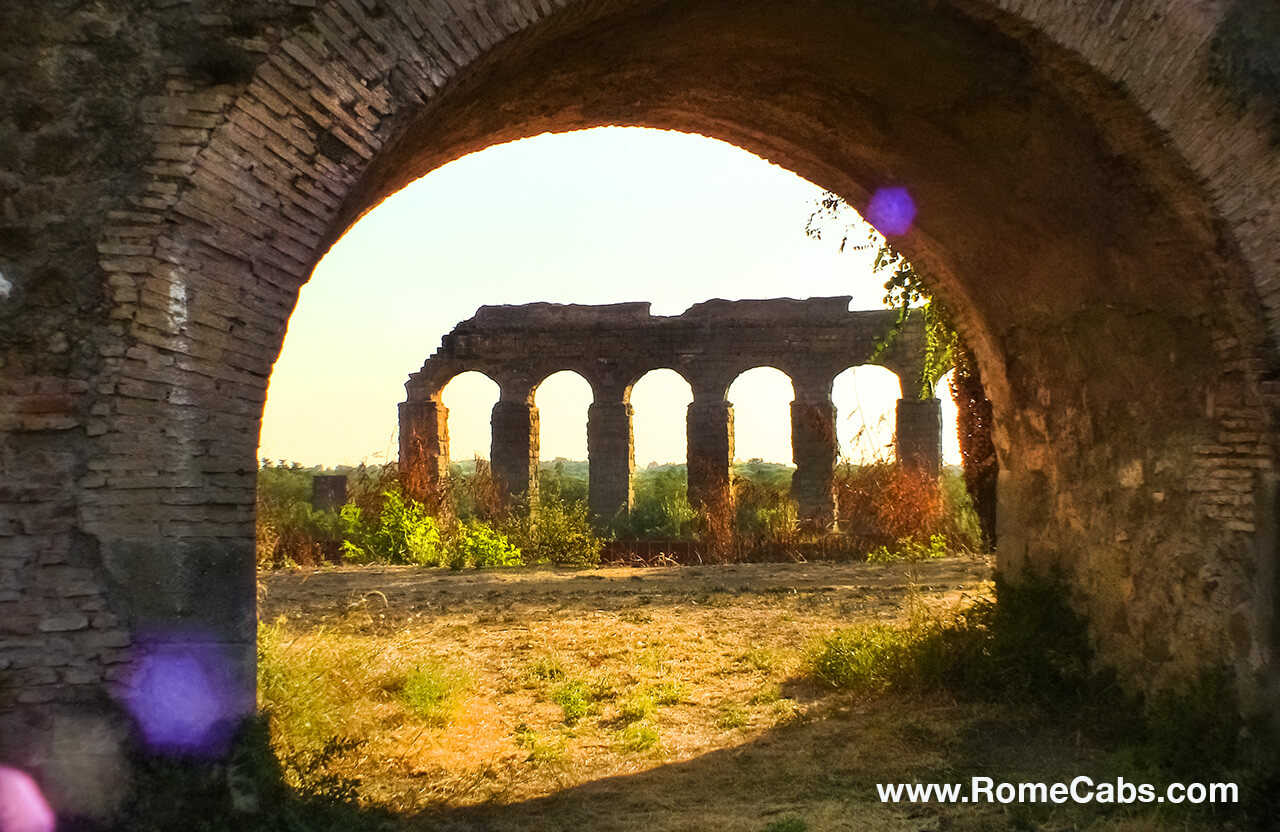
Villa of the Quintilii:
Nestled within the park is the magnificent Villa of the Quintilii, once the opulent residence of the Quintilii brothers, wealthy Roman aristocrats. The villa boasts beautifully preserved ruins, including expansive courtyards, thermal baths, and splendidly decorated rooms. As you wander through the villa's remains, you'll get a glimpse of the luxurious lifestyle enjoyed by the Roman elite.
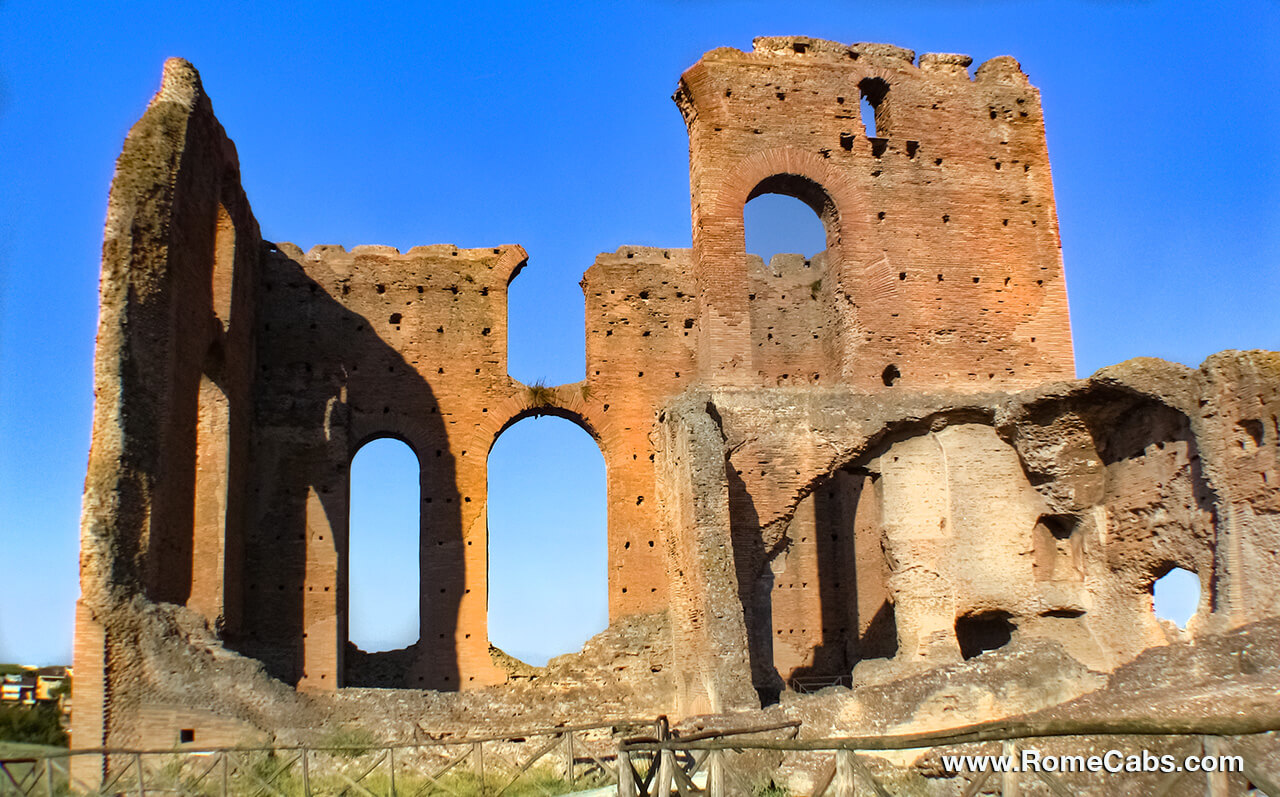
Via Latina Tombs:
Along the Via Latina, a road that intersects with the Appian Way, you'll find an intriguing collection of ancient tombs. These tombs, hewn into the rock face, showcase different architectural styles and provide insights into the burial customs of ancient Romans. The Via Latina Tombs are a testament to the rich funerary traditions and the reverence for the afterlife in ancient Rome.
Appian Way Park also offers ample opportunities for outdoor activities and recreation. The vast open spaces are perfect for picnics, jogging, or cycling along the tree-lined avenues. There are designated areas for horseback riding, allowing you to experience the park from a different perspective. Exploring the park on foot or by bike enables you to uncover hidden gems, discover secluded spots, and enjoy the tranquil ambiance of this historic landscape.
Via Appia stands as a majestic testament to ancient Roman engineering and history. From its strategic importance in Roman politics to its connection with St. Peter and its role as a gateway to many faraway destinations, the Via Appia has captivated travelers for centuries.
At Stefano’s RomeCabs, we invite you to experience the grandeur of the Via Appia and its surrounding treasures on our Tours of Italy, Civitavecchia Shore Excursions, and Post Cruise Tours from Civitavecchia.
Our knowledgeable English-speaking drivers will take you to many fascinating destinations ensuring you don't miss the hidden gems and remarkable sites that await. Whether you choose to visit the awe-inspiring catacombs, explore the ruins of ancient villas, or marvel at the architectural wonders of the aqueducts, our carefully curated tours will bring the wonders of Ancient Rome to life.
We look forward to showing you beautiful places in Italy!
* Find us online also on:
